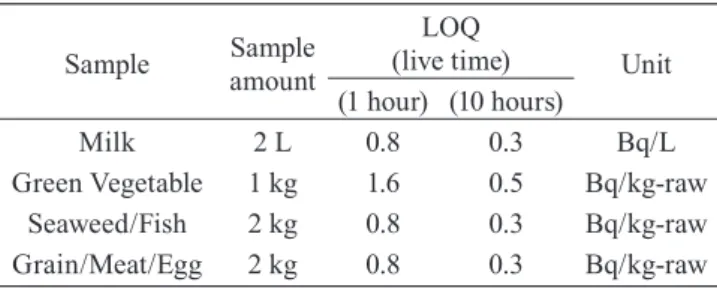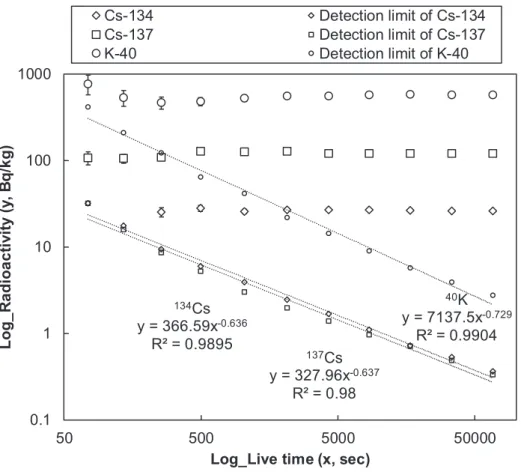Pretreatment conditions for detecting 134Cs -Eight years after the Fukushima Daiichi nuclear accident-
全文
(2) 26. J. Nucl. Radiochem. Sci., Vol. 20, 2020. Shozugawa. considered equivalent to 0.8 Bq/kg. Even one hour was too long to determine the 137Cs activity concentration in milk if it exceeded the regulatory level. As described previously, although a measurement guideline is available, quantitative evaluation of the measurement time and the LOQ or detection limit remains sparse for gamma ray analysis. Here a general solution is examined using results from actual measurements. Figure 1 presents the radioactivity of 134Cs, 137Cs, and 40K with respect to measurement time (live time) and detection limits for dried shiitake mushrooms that were manufactured and sold in Yugawara City, Kanagawa Prefecture, in January 2014. The dried mushroom sample had a density of 0.422 g/ cm3 and weight of 0.844 kg and was crushed and measured in a 2-L Marinelli vessel without pretreatment. The radioactivities of 134Cs, 137Cs, and 40K at a measurement time of 67,500 s (live time) were 26.3 ± 0.2, 120 ± 0.6, and 578 ± 5 Bq/kg, respectively. The radioactivity of radioactive cesium (sum of 134Cs and 137Cs) in the dried mushroom sample was 147 ± 0.6 Bq/kg at the time of measurement. This value was below the regulatory limit of 570 Bq/kg for dried shiitake mushrooms and thus suitable for distribution in Japan. 40 K was first determined to be 774 ± 200 Bq/kg at a live time of 75 s. Since the detection limit was 420 Bq/kg 75 s after measurement started, it was determined in excess of 3σ. However, the coefficient of variation (c.v.), which is an indicator of accuracy, fell below 10% after the measurement time exceeded 1000 s. Although the sum of the radioactivities of 134Cs and 137Cs was lower than the 40K activity concentration, the measurement time was not required to determine accuracy. The c.v. for the radioactivity of 134Cs and 137Cs were below 10% at 496 and 257 s, respectively. This was mainly because the detection efficiency near 0.6 MeV was approximately two times higher than that near 1.4 MeV. The detection limit could be approximated as a function of. Cs-134 Cs-137 K-40. the live time under ideal conditions, such that the gamma ray analysis ignored Compton scattering, summing peaks from the photopeaks of higher energy than targeted peaks. For foodstuffs, this approximation was applied because natural nuclides, except 40K, were often absent. The detection limit for 137Cs was related to the live time by an exponent based on values for the 11 data points in Fig. 1. This relationship yielded a detection limit of 0.054 Bq/kg for measurements from 14 consecutive days. Measurements of the radioactivity of cesium in approximately 259 food samples7 using 2L Marinelli vessels and the HPGe detector revealed that the detection limit for 134Cs or 137 Cs was 0.05 Bq/kg for a reasonable live time (up to 2 weeks) regardless of the radioactivity or density. Thus, increasing the measurement time was an inefficient method for lowering the detection limit. Conversely, sample concentration before counting gamma rays was very effective in lowering the detection limit. Removing water from samples by heating was a suitable method for concentrating radiocesium. According to our previous study,11 the 133Cs loss rate from heating was approximately 0.4%. Therefore, if the sample was prepared, radiocesium could be determined more efficiently by concentrating samples by heating for water removal. 3.2. Pretreatment conditions for the detection of 134Cs nine years after the Fukushima Daiichi nuclear disaster. On the 8th anniversary of the Fukushima Daiichi nuclear disaster (March 11, 2020), the activity ratio of 134Cs to 137Cs was expected to be approximately 0.06.8 Therefore, if a conventional Ge semiconductor detector (134Cs detection limit 0.05 Bq/kg) was used, the theoretical required radioactivity of 137Cs would be at least 0.833 Bq/kg. This theoretical radioactivity assumed that all detectable 137 Cs or iginated f rom the Fukushima Daiichi nuclear disaster. In Japan, pre-Fukushima events, such as nuclear bombs in. Detection limit of Cs-134 Detection limit of Cs-137 Detection limit of K-40. Log_Radioactivity (y, Bq/kg). 1000. 100. 10 40K y = 7137.5x-0.729 R² = 0.9904. 134Cs. y = 366.59x-0.636 R² = 0.9895. 1. 137Cs. y = 327.96x-0.637 R² = 0.98 0.1. 50. 500 5000 Log_Live time (x, sec). Figure 1. Radioactivity and detection limit (3 sigma) of 134Cs, 137Cs, and 40K relative to live time (s).. 50000.
(3) Pretreatment conditions for detecting 134Cs -Eight years after the Fukushima. 1945, atmospheric nuclear weapons testing in other countries (1950s and 1960s), and the Chernobyl disaster in 1986 introduced 137Cs to the environment. Therefore, 137Cs detected in most samples exceeded the theoretical radioactivity calculated from the 134 Cs/137Cs ratio based on the Fukushima Daiichi nuclear disaster. Pretreatment methods depended on the sample type. For large fish living and caught in the North Pacific Ocean, approximately 50% of the 137Cs content was attributed to the Fukushima Daiichi nuclear disaster.7 Salmon caught in Hokkaido, Japan had 137Cs yields of approximately 0.1 Bq/kgraw level. 7 Therefore, 137Cs source discrimination for fish samples required quantification of at least 1.6 Bq/kg 137Cs after concentration. That is, concentration to 16 times by weight was required prior to gamma ray counting. This is not a realistic pretreatment method. Conventional HPGe with a detection efficiency of 25% was used in this study; however, other approaches, such as using a Ge semiconductor detector with a higher detection efficiency, a higher peak over Compton ratio, or a low-back environment, could lower the detection limit. Although the application range was limited to Japan, to efficiently detect 134Cs for investigating 137Cs sources, pre-measuring 137Cs radioactivity or extracting it from a database12 and calculating the concentration ratio from the 134Cs/137Cs ratio backwards from the radioactivity could be effective. 4. Conclusions Several years after the Fukushima Daiichi nuclear disaster, the quantification of 134Cs over time has become difficult. The absolute detection efficiency of 134 Cs for the conventional HPGe using a 2L Marinelli vessel was approximately 0.1%. Under these conditions, the achievable detection limit was approximately 0.05 Bq/kg, even if samples were measured for 2 weeks. Concentrating the sample by removing water was more effective for decreasing detection limits than extending the measurement time. As of March 2019, to quantitatively distinguish the sources of 137Cs from the Fukushima Daiichi nuclear disaster and previous events like the Chernobyl accident, a sample with 137Cs of approximately 0.1 Bq/kg-fresh. J. Nucl. Radiochem. Sci., Vol. 20, 2020. 27. would require at least 16 times 137Cs concentration on a weight ratio basis. Since such an enrichment of radioactivity levels is not feasible, a sample with higher radioactivity should be chosen, or a high-performance germanium semiconductor detector should be used. References (1) G. Steinhauser, Environ. Sci. Technol. 48, 4649 (2014). (2) S. Merz, G. Steinhauser, and N. Hamada, Environ. Sci. Technol. 47, 1248 (2013). (3) N. Hamada and H. Ogino, J. Environ. Radioact. 111, 83 (2012). (4) N. Hamada, H. Ogino, and Y. Fujimichi, J. Radiat. Res. 53, 641 (2012). (5) Ministry of Health, Labour Welfare, Japan, New standard limits for radionuclides in foods, http://www.mhlw.go.jp/ english/topics/2011eq/dl/new_standard.pdf (accessed 23 December, 2019). (6) Ministry of Health, Labour Welfare, Japan, About handling the testing method of radioactive materials in food, https:// www.mhlw.go.jp/shinsai_jouhou/dl/shikenhou_120319.pdf (in Japanese) (accessed 23 December, 2019). (7) M. Hori, T. Saito, and K. Shozugawa, Sci. Rep. 8, 16806 (2018). (8) H. Kaiser, Fresenius’ Zeitschrift für Analytische Chemie. 209, 1 (1965). (9) Ministry of Education, Culture, Sports, Science and Technology, Japan, The guidline of Gamma ray spectrometry for Ge semiconductor detector in Series of Radioactivity measurement (1992) (in Japanese). (10) Ministry of Health, Labour Welfare, Japan, Reference for determination of radioactivity in foodstuff, https://www. m h l w. g o . j p / s t f / h o u d o u / 2 r 9 8 5 2 0 0 0 0 0 1 5 5 8 e - i m g / 2r98520000015cfn.pdf (in Japanese) (accessed 23 December, 2019). (11) K. Shozugawa, T. Saito, M. Hori, and M. Matsuo, J. Radioanal. Nucl. 307, 2117 (2016). (12) Ministry of Health, Labour Welfare, Japan, Database of radioactive substances in food, http://www.radioactivitydb.info/ (in Japanese)..
(4)
図


関連したドキュメント
In order to provide for compensation payments for nuclear damages concerning the accident of Fukushima Daiichi Nuclear Power station damaged by the Tohoku-Chihou-Taiheiyou-Oki
Amount of Remuneration, etc. The Company does not pay to Directors who concurrently serve as Executive Officer the remuneration paid to Directors. Therefore, “Number of Persons”
For short-term measures based on the accident at the Fukushima Daiichi Nuclear Power Station, depth of subsidence due to deformation of the culvert having a low antiseismic
○ There was no wind pressure but we heard a sound like a balloon popping. Then everything went white and after little bit I heard a sound like pitter patter and I thought that
Reactor automatically trip (scram) Electrical power supplied by transmission lines Power provided by generator operating with diesel fuel (emergency diesel generator) Cooling by
Situation of storing and treatment of accumulated water in the building (actual record) Stored amounts in each unit building (Units 1 to 4 (including condensers and trenches)), and
Fukushima Daiichi Unit 5 was restored and achieved cold shutdown by getting access to power from the emergency DG of Unit 6 and installing a temporary underwater pump to replace
The following measures were implemented and it has been confirmed that the total amount of accumulated radioactive water has been reduced by processing the accumulated